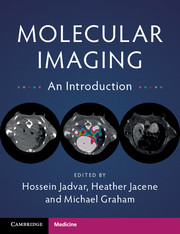Book contents
- Frontmatter
- Contents
- List of Contributors
- Preface
- 1 Instrumentation – CT
- 2 MRI/ MRS Instrumentation and Physics
- 3 Optical and Ultrasound Imaging
- 4 Instrumentation-Nuclear Medicine and PET
- 5 Quantitation-Nuclear Medicine
- 6 Perfusion
- 7 Metabolism
- 8 Cellular Proliferation
- 9 Hypoxia
- 10 Receptor Imaging
- 11 Apoptosis
- 12 Angiogenesis
- 13 Reporter Genes
- 14 Stem Cell Tracking
- 15 Amyloid Imaging
- Index
- References
13 - Reporter Genes
Published online by Cambridge University Press: 22 November 2017
- Frontmatter
- Contents
- List of Contributors
- Preface
- 1 Instrumentation – CT
- 2 MRI/ MRS Instrumentation and Physics
- 3 Optical and Ultrasound Imaging
- 4 Instrumentation-Nuclear Medicine and PET
- 5 Quantitation-Nuclear Medicine
- 6 Perfusion
- 7 Metabolism
- 8 Cellular Proliferation
- 9 Hypoxia
- 10 Receptor Imaging
- 11 Apoptosis
- 12 Angiogenesis
- 13 Reporter Genes
- 14 Stem Cell Tracking
- 15 Amyloid Imaging
- Index
- References
Summary
Introduction
Positron emission tomography (PET) is a noninvasive clinical imaging modality that can be combined with reporter gene expression to enable the specific and repetitive detection of a variety of cellular processes. These cellular processes include transcriptional regulation, signal transduction, protein-protein interactions, and cell trafficking and engraftment. The ability to detect these processes with PET reporter gene/probe systems also enables non-invasive monitoring of the pharmacokinetics and pharmacodynamics of therapeutics and their efficacy in vivo.
The concept of reporter gene imaging emerged from systems designed to image intrinsic enzymatic and metabolic processes and targets leading to the development of the reporter/radiotracer concept. The premise of reporter gene-based expression is based on the irreversible binding or entrapment and accumulation of reporter probes (radiotracers). These reporter probes are labeled with positron-emitting radionuclides. Accumulation of the probes in or at target cells is mediated by the catalytic activity of the reporter gene products (enzymes), their binding affinity to the reporter proteins or transport through reporter proteins. This reporter gene-mediated binding, accumulation, and retention of positron-emitting reporter probes in target cells enables repetitive spatial-temporal dynamic imaging of molecular and cellular events by PET.
Reporter-based imaging requires the transfer and expression of a reporter gene into target cells by transfection, electroporation, or transduction. These reporter genes are encoded within expression cassettes which initiate and control their expression. These control elements fall into two general categories: constitutive and conditional. Constitutively expressed reporters are used to “label” cells ex vivo for studies that require monitoring of trafficking and distribution patterns of the infused cells. The utility of this method has been most routinely illustrated in adoptive immunotherapy applications where T cells are labeled to determine their trafficking, biodistribution, and targeting patterns. It is also used in stem cell therapy applications to determine the long-term viability and therapeutic efficacy of infused stem cells.
Reporter gene expression driven by conditional tissue-specific promoters provides functional information about the target cells. Conditional promoters, for example, can provide information about the functional status of T cells related to their activation and proliferation and telomerase activity in tumor cells. PET reporters fall into three basic categories: enzyme-, receptor-, and transporter-based systems (Figure 13.1).
- Type
- Chapter
- Information
- Molecular ImagingAn Introduction, pp. 55 - 64Publisher: Cambridge University PressPrint publication year: 2017



